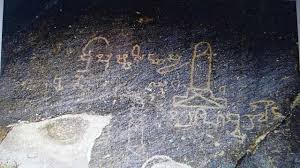ASI Decodes Sanskrit Inscription Found in Pakistan-Occupied Kashmir (PoK)

- 29 Dec 2024
In News:
An ancient Sanskrit inscription found in Gilgit (PoK) was decoded by the Archaeological Survey of India (ASI).
About the Inscription:
- Location:
- Gilgit (PoK): Written in Brahmi script, dating back to 4th century CE.
- Peshawar (Pakistan): Written in Sharada script, dating to 10th century CE.
- Details of Gilgit Inscription:
- Mentions Pushpasingha, who installed a Mahesvaralinga for the merit of his guru.
- Written in Brahmi script, which was prevalent during the 4th century CE.
- Religious Context: Indicates significant religious connection, particularly with Shaivism.
- Details of Peshawar Inscription:
- Fragmentary: Engraved on a slab.
- Written in Sharada characters (10th century CE).
- Mentions Buddhist Dharini (chants), particularly referring to Da (Dha) rini in line six.
- The inscription is partially damaged, and further details are unclear.
- Earlier Discoveries:
- This is not the first Sanskrit inscription decoded from Pakistan. In the past, Sanskrit inscriptions have been found in various parts of Pakistan.
- Swat Valley: Known for numerous Buddhist rock inscriptions in Sanskrit using Nagari script, which were part of the Gupta Empire (circa 240–550 CE).
- Religious and Cultural Implications:
- The Gilgit inscription provides evidence of Shaivism as a prominent religious practice in the region during the 4th century CE.
- The Peshawar inscription suggests Buddhist influences, particularly related to Buddhist chants and rituals.
- Swat Valley's Role: The inscriptions found here highlight its importance as a center of Buddhist learning and cultural exchange.
